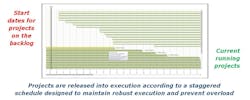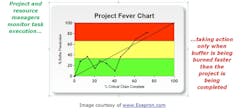Some new product organizations swear by a Project Management Office with dedicated project managers. Others do just fine with the primary engineer on the project also leading it. Me? I’m agnostic – you just have to figure out what works best in your culture and then double down on it.
But one thing I’m not agnostic about is the need to eliminate the waste inherent in most projects. Yes, eliminating waste isn’t just a lean manufacturing thing. But projects involve knowledge work. That makes it much more difficult to see the waste and the work in process that clogs the system. I’ve coached and trained hundreds of project managers, yet I’m still amazed to hear how much of their time is waste vs. useful activity moving projects forward. In my experience, the average lead engineer also serving as project manager spends more than half their time managing those projects—far more than is necessary in the majority of cases.
PMI suggests that project management resources should range somewhere between 15-20% of the resources for all your project. At first glance, that sounds pretty high – after all, most of the people working on projects also have functional managers, too. But there’s a reason it needs to be that high – it’s the waste inherent in traditional project and resource management.
So why call that time waste in the first place? It’s only the time required to run a successful project – Isn’t it? Maybe not. Here are a few examples of wasted time in project tasks:
- Cajoling tasks owners to stop what they are doing and work on their task
- Chasing status updates on individual tasks, including expected completion dates
- Negotiating priorities when a resource is conflicted between multiple projects needing their work
- Attending update meetings for replanning as the project timeline slips
- Doing status reporting, which rarely indicates a problem until the last 20-30% of the project—when it’s too late to recover
- Last-quarter fire drills in an attempt to get the project done on time
By the way, do you notice the waste doesn’t stop at your project managers? Most of these examples include people across the organization. And often their managers have to get involved, too. So their limited time is wasted on urgent firefighting instead of the important but not urgent activities that could move the company ahead—what business management guru Eli Goldratt referred to as the constraint of management attention.
The root causes for all of these different types of waste are embedded in conventional practice:
- Multitasking that consumes capacity. Managers believe it’s better for everyone to stay busy, so people often bounce back and forth staying busy – but busy isn’t the same as productive.
- Running too many projects at the same time. Without a throttle to control their resources, most companies overload their resources. As a result, everything moves an inch, and nothing moves a mile.
- Milestone mentality that causes procrastination. Traditional project plans are 50-70% padding because the people doing them expect to be spread thin and required to multitask. But this safety just encourages resources to procrastinate until the last possible minute, a phenomenon known as student syndrome.
Attacking these causes at their roots takes a different approach – one that Goldratt coined as Critical Chain Project Management (CCPM).
Critical Chain Project Management
CCPM can be a key element in your fight against project management waste. And while it sounds similar, it’s quite different from the conventional critical path used by most project managers. Here’s a quick rundown of how it works:
1. Plan working backwards from your target. Ask what has to be done before you can start each task and work back to the beginning. The result is a network showing the order of execution and what task can be done in parallel to shorten the duration.
2. Assign resources and durations to each task in the network. Durations are based on touch time – the amount of time required with no interruption or problems and should only have a 50% likelihood of being long enough. These aggressive times, usually half of what you would normally plan, are critical to avoiding embedded procrastination.
3. Identify the projects’ critical chain (there are numerous software tools available to do so) or the longest sequence of tasks respecting the network and the resources available. This eliminates any scheduled multitasking since a given resource can only do one thing at a time.
4. Add a safety buffer at the end of the project. We removed half of a conventional plan’s duration by taking the safety out of each task. We still need to protect the project’s due date from uncertainty by adding a project buffer equal to half the duration of the critical chain. This buffer is also a critical visual signal during execution.
5. Schedule the project into your execution pipeline as resource bandwidth allows. Compare the project’s resource loading on a week-by-week basis with the free capacity in your portfolio. Push the start date of the new project out until it does not cause any resource overloading. This is a critical step in making sure each project moves at full speed and that existing projects aren’t derailed when new ones enter.
6. Work to a relay race ethos during execution. Move each task as quickly as possible without any interruption or multitasking, until it’s ready to hand off to the next runner.
7. Have the people doing the work report progress every day. With modern CCPM software, this reporting takes less than a minute and can even be done via smartphone.
8. Track progress visually by comparing the amount of project buffer burned to the percentage of the critical chain remaining you can tell how the project is doing. The project manager then leads all buffer recovery efforts — a critical role anytime buffer is being burned faster than critical chain tasks are being completed.
9. Make the day-to-day execution priorities crystal clear. Projects enter the pipeline in an order reflecting strategic priorities. However, once execution begins, the portfolio status chart shows where the priorities should be. If a resource has two tasks available, they should work the one most at risk of finishing late (highest buffer burned vs. critical chain completed).
Putting CCPM to Work
Executing projects in a CCPM environment takes more than adding a new tool set. It’s a cultural change that requires organizational buy-in, new disciplines, and improved governance mechanisms. But the benefits far outweigh the investment. Companies that embrace CCPM report an average cycle-time reduction of 30-50%. As importantly, they finish 30-50% more projects and their projects finish on time with greater than 90% reliability.
Mike Dalton is the author of Unlocking Innovation Productivity and the founder of Guided Innovation: Helping Industrial B2B Manufacturers that Are Tired of Delays Take the Waste Out of New Product Innovation. Mike’s report, "Dealing with New Product Delays… When Throwing Money at It Isn't the Answer,"outlines areas for removing the project management waste and uncovering hidden innovation productivity.
About the Author
Mike Dalton
Managing Director
Mike Dalton is the founder of Guided Innovation Group, where for nearly 20 years he has helped leaders in highly engineered product companies make new products a reliable competitive advantage. He has contributed numerous Industry Week articles and is the author of Unlocking Innovation Productivity and Simplifying Innovation.



